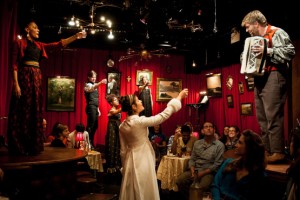by Dan Venning
Some of the most exciting theatre in New York takes place far from the commercial stages of Broadway. Off-off Broadway theatres—venues with fewer than one hundred seats—all stage experimental shows aimed at more limited audiences. Frequently called “downtown theatre,” off-off Broadway tends to cater to a younger, hipper crowed than Broadway and Off-Broadway theatres. These shows can be “experimental” in a variety of ways: by playing with form and genre, telling stories less likely to appeal to mass audiences, or presenting the works of emerging artists or those whose style clashes with the mainstream. Sometimes, downtown theatre can unfortunately seem unfinished or unprofessional, but at other times one feels especially lucky to be among the few New Yorkers who got to see a true gem. This month, I saw a variety of productions that were part of this experimental scene, starting with the annual PRELUDE festival at the Martin E. Segal Theatre Center at the Graduate Center, and then at shows at Ars Nova and HERE.
This first post will look at a wonderful show at Ars Nova, Natasha, Pierre & the Great Comet of 1812. Natasha, Pierre was billed as an “Electro-Pop Opera.” The Composer-in-Residence at Ars Nova, Dave Malloy (who also co-created Black Wizard / Blue Wizard at PRELUDE), composed the music and adapted the libretto from sections of Tolstoy’s War and Peace. Malloy also serves as Music Director, plays various instruments, and performs the lead role of Pierre.
Malloy’s opera is unconventional in many senses. Malloy says he takes his inspiration both from the operatic form and pop electronic music such as the work of Radiohead and Björk, but he also infuses his music with melodies that seem at times to come straight from nineteenth-century Russia, blending polka, punk, and folk rock much like bands such as Gogol Bordello. As staged by Rachel Chavkin, the Obie-winning Founding Artistic Director of The TEAM, Natasha, Pierre takes place among and around audience members who are seated closely together around tables and at a bar in a theatre converted to look like a nineteenth-century Russian supper club. (Mimi Lien’s set is modeled after an actual supper club Malloy visited in Russia two years ago). Audience members are served potato dumplings and traditional Russian bread, as well as complimentary vodka. In these respects, Natasha, Pierre seems like the model of interactive downtown theatre. But Malloy’s aesthetics are grounded in musical and technical mastery: his work, two hours and ten minutes of continuous music for singers and six to ten instruments, is every bit as much an opera as works staged at the Met. It is a magnificent opus, and little surprise that the show received glowing notices in The New York Times and other papers; when it extended, the added performances sold out in two hours.
The show requires no familiarity with War and Peace: the program includes a synopsis, a chart showing the characters and their interconnections, and the opening number, “Prologue,” is used to introduce the audience to the characters and their defining characteristics. Yet for those who have read and remember the novel, Malloy and Chavkin have included small “Easter eggs”—moments that allude to some of the many elements of Tolstoy’s novel not included in Malloy’s opera. Natasha, Pierre, in fact, consciously jettisons the “War” part of its source material. The opening song includes lyrics that acknowledge that “There’s a war going on out there . . . and Andrey [one of the main characters in Tolstoy’s novel] isn’t here.” Despite his central role in the book, Andrey barely appears in the opera, his name invoked by all the characters as the specter of an absent friend, brother, fiancé, and son.
The title Natasha, Pierre is indeed appropriate: the first half of the opera deals with the life of Natasha (Phillipa Soo), Andrey’s fiancée, when she moves to Moscow, while the second half focuses on Pierre (Malloy), Andrey’s best friend. While Andrey is off fighting in the war, Natasha falls for the charming Anatole (Lucas Steele), who is secretly already married. They attempt to elope, but their plot is foiled by Natasha’s godmother (Amelia Workman). Pierre appears only peripherally in the first half, but takes center stage in the second half of the show, proving himself to be invaluable to his friends as he sets things right, as best as possible, for Andrey, Natasha, and Anatole.
The acting and singing are strong all around, but particular praise is due to Gray, who is alluring yet still emotionally affecting as Hélène, a representative of the moral depravity of Moscow, and Steele, whose chiseled good looks and angelic singing voice make clear why Natasha falls for him. The slightly schluby Malloy is perfect for the role of Pierre, and his singing voice, although more reminiscent of Tom Waits than traditional musical theatre or opera, fits wonderfully within the show’s musical stylstics. Malloy’s music truly rocks, but some songs, such as the “Prologue” and “The Private and Intimate Life of the House,” a duet between Andrey’s sister Mary (Gelsey Bell) and father Bolkonsky (Blake DeLong) particularly stand out. The performances and immersive set are complemented by Paloma Young’s beautiful costumes, a mix of period and contemporary. Bradley King’s clever and eccentric lighting design, featuring chandeliers with light bulbs fanning out like solar systems, seem a fusion of nineteenth-century, steampunk, and Googie design, and make for a particularly moving conclusion as one of the lights becomes the great comet of the title. Natasha, Pierre & the Great Comet of 1812 is a triumph of downtown theatre.

